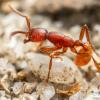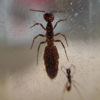- Formiculture.com
- Forums
- Gallery
- Members
- Member Map
- Chat

Neivamyrmex opacithorax
Started By
PurdueEntomology
, May 5 2020 3:36 PM
193 replies to this topic
#181
 Offline
-
Posted June 16 2020 - 6:36 PM
Offline
-
Posted June 16 2020 - 6:36 PM
I honestly hope to try keeping neivamyrmex or any army ant someday, but right now i am fine with slave makers.
My journals:
Polyergus Mexicanus: https://www.formicul...gs/#entry175528
Lasius minutus: https://www.formicul...cs/#entry174811
Lasius latipes: https://www.formicul...gs/#entry206449
General acanthomyops journal: https://www.formicul...yops-with-eggs/
Polyergus Mexicanus: https://www.formicul...gs/#entry175528
Lasius minutus: https://www.formicul...cs/#entry174811
Lasius latipes: https://www.formicul...gs/#entry206449
General acanthomyops journal: https://www.formicul...yops-with-eggs/
#182
 Offline
-
Posted June 21 2020 - 2:02 PM
Offline
-
Posted June 21 2020 - 2:02 PM
I honestly hope to try keeping neivamyrmex or any army ant someday, but right now i am fine with slave makers.
Personally, after this 2nd round I think overall they are not a genus to be containerized save for short term behavioral studies.
- gcsnelling and Antennal_Scrobe like this
#183
 Offline
-
Posted June 24 2020 - 2:23 PM
Offline
-
Posted June 24 2020 - 2:23 PM
I will definitely be releasing the colony tomorrow!! I have isolated the queen with a number of workers to make sure I know she is okay. I will take the container and open the attachment points and place a small tube to touch the ground and just allow them to move out on their own.
- gcsnelling and TennesseeAnts like this
#184
 Offline
-
Posted June 24 2020 - 6:16 PM
Offline
-
Posted June 24 2020 - 6:16 PM
Good to know they survived ![]()
#185
 Offline
-
Posted June 25 2020 - 6:20 AM
Offline
-
Posted June 25 2020 - 6:20 AM
And how would you go about getting your hands on some?I honestly hope to try keeping neivamyrmex or any army ant someday, but right now i am fine with slave makers.
"God made..... all the creatures that move along the ground according to their kinds (including ants). And God saw that it was good. Genesis 1:25 NIV version
Keeping:
Tetramorium immigrans Camponotus vicinus, modoc, novaeboracensis, herculeanus
Formica pallidefulva, argentea Solenopsis molesta
Formica cf. aserva Lasius brevicornis, neoniger
#186
 Offline
-
Posted June 25 2020 - 6:51 AM
Offline
-
Posted June 25 2020 - 6:51 AM
And how would you go about getting your hands on some?I honestly hope to try keeping neivamyrmex or any army ant someday, but right now i am fine with slave makers.
if you can find a colony via tracing a trail, its relatively simple to find a colony nesting close to the surface and simply collect them while dumping them into a fluon lined bin.
#187
 Offline
-
Posted June 25 2020 - 6:58 AM
Offline
-
Posted June 25 2020 - 6:58 AM
In Canada, I mean.if you can find a colony via tracing a trail, its relatively simple to find a colony nesting close to the surface and simply collect them while dumping them into a fluon lined bin.And how would you go about getting your hands on some?I honestly hope to try keeping neivamyrmex or any army ant someday, but right now i am fine with slave makers.
- Antkeeper01 likes this
"God made..... all the creatures that move along the ground according to their kinds (including ants). And God saw that it was good. Genesis 1:25 NIV version
Keeping:
Tetramorium immigrans Camponotus vicinus, modoc, novaeboracensis, herculeanus
Formica pallidefulva, argentea Solenopsis molesta
Formica cf. aserva Lasius brevicornis, neoniger
#188
 Offline
-
Posted August 6 2021 - 8:39 AM
Offline
-
Posted August 6 2021 - 8:39 AM
As of today I have a Neivamyrmex opacithorax colony that has been doing very well for two months. This time round I have decided to keep them in large trays with plenty of soil. The issue with previous attempts have to my estimation been, 1) inadequate size containers with too much light/disturbance, and 2) more CRITICALLY, parasitic mites. My assumption is this type of ant will always have some presence of parasitic mites, it is just in a natural setting mite infestations are kept to tolerable levels. Containerizing and perhaps "stress" due to that weakens the ants and the mites get a foot hold and decimate the colony.
With this new set up I have gone through two brood cycles without loss of ants, I have not found one dead worker yet. I have reduced feeding from previous attempts to one feeding every 48 hours with a small quantity of Solenopsis invicta brood. This seems to be a good balance of reducing fungus and pathogens yet maintaining caloric intake for brood production and colony needs.
I have also attached new large containers with fresh soil so the ants can move from one to another, thus helping to reduce time spent in "old" soil, soil that may have a pest or pathogen population build up.
As is their nature, they are primarily subterranean. This means I see the at night during feedings and that's it, no allowance for looking at brood etc out of curiosity , save occasionally to assess brood status and queen status. I feel this is a species sensitive to disturbance.
- gcsnelling, TennesseeAnts, NickAnter and 5 others like this
#189
 Offline
-
Posted August 6 2021 - 9:56 AM
Offline
-
Posted August 6 2021 - 9:56 AM
Very Nice! Looks like everyones gettin neiva again, first Cheeto and now You. Good luck on these, hopefully they work out
- Antkeeper01 likes this
#190
 Offline
-
Posted August 6 2021 - 1:09 PM
Offline
-
Posted August 6 2021 - 1:09 PM
I feel like I have to question some of your methods here...
Maybe it's just because of the location, but neither of my Neivamyrmex colonies have ever had parasites or any sort of disease. My old colony did very well in captivity, before escaping, and the colony I recently collected is also doing just fine in artificial nests. I also feed them primarily, if not exclusively, brood from captive colonies, so that I know they are clean from parasites and disease.
I am also incredibly intrigued by your decision to use dirt setups. If you have consistently had issues with parasitic mites, wouldn't artificial formicaria be better? Parasitic mites need soil to lay their eggs, and if they're in soil they could have mites without you ever noticing, no? Not to mention that you're probably not seeing any dead workers because they don't remove their dead from their old nests; that's their whole thing with being nomadic. They don't bother to clean out old nesting sites since they never plan to use them again. This is why artificial setups are so good, since after the colony migrates you can disconnect and deep-clean their old nest before re-attaching it to the setup.
If you've been able to go two full cycles without any noticeable health concerns then maybe I'm wrong, but personally I don't believe the type of setup that you have detailed to be ideal for this type of ant. They seem to be the type that needs constant monitoring so that you are able to adjust their care appropriately with their needs.
Here's my journal btw, in case anyone doubted that I know what I'm talking about ![]()
https://www.formicul...mex-updated-85/
Edited by CheetoLord02, August 6 2021 - 1:11 PM.
- Mdrogun, TennesseeAnts, 11.11.00 and 4 others like this
I like leafcutter ants. Watch The Ultimate Guide to Fungus Growing Ants:
https://youtu.be/VBH...4GkxujxMETFPt8U
This video took like over 100 hours of work, you should for sure watch it.
#191
 Offline
-
Posted September 8 2021 - 6:38 AM
Offline
-
Posted September 8 2021 - 6:38 AM
The colony is still doing well. I have not noticed any parasitic mites which is great. CheetoLord02 seems to have a good approach. My personal observations with Neivamyrmex though tends to see them as a genus that even if containerizable (neologism) are extremely sensitive to disturbances. Due to this I still want to to keep the colony in large soil based containers. Last night the colony shifted itself from their second container to a container with fresh soil (their 3rd container shift). With shorter days and cooler nights I would expect behavior shifts towards over wintering preparations. N. nigrescens has been reported to overwinter in up to 3 foot deep locations. Our temperate Neivamyrmex do not overwinter with brood either, at least in geographic ranges that experience cold winters, i.e., TN. Colonies reactive in the spring where raiding begins afresh, queens eat and then start to produce eggs.
- gcsnelling, TennesseeAnts and Antkeeper01 like this
#192
 Offline
-
Posted September 10 2021 - 4:01 PM
Offline
-
Posted September 10 2021 - 4:01 PM
I see you are having success.
I recently aquired a batch of nigrescens. My usual collecting area is rich with neivamyrmex. 5 colonies total from what I have seen in that small area, 2 opacithorax, 3 nigrescens. Though I collected a batch. So 4 now with the the remaining workers and brood of the 5th that I did not catch. I have been applying a (queen bee) technique with the queen. I put her in a tube with holes that she cannot escape but the workers can enter. The ants get attracted to her and I collect them.
I have caught two queens this year. The first batch I let go as I suspected the queen had not mated yet. She was part of a colony that divided not to long before I captured her.
I knew that it was going to happen as I had found reproductive brood in there bivouac site. They were in their pupal phase. That nest site was a cool discovery as some of the bivouac was actually out in the open. Which is a similar behavior to E. burchellii when they have reproductives developing.
I did not get to witness the fission process unfortunately but I inferred it happened when I figured out there were now two separate batches.
The newer queen also appeared to have a lighter colour. Not callow, but fresher looking... if that makes sense. I eventually let her go with the workers I had caught after I aquired another batch.
I still go out at night to catch the remaining workers that I did not catch the first night.
Termites have been readily taken for food. If I get a good Nomadic-Statary behavior going soon I will start collecting and freezing some food to last me through the winter. If they do not start that cycle, though I will release them.
I recently aquired a batch of nigrescens. My usual collecting area is rich with neivamyrmex. 5 colonies total from what I have seen in that small area, 2 opacithorax, 3 nigrescens. Though I collected a batch. So 4 now with the the remaining workers and brood of the 5th that I did not catch. I have been applying a (queen bee) technique with the queen. I put her in a tube with holes that she cannot escape but the workers can enter. The ants get attracted to her and I collect them.
I have caught two queens this year. The first batch I let go as I suspected the queen had not mated yet. She was part of a colony that divided not to long before I captured her.
I knew that it was going to happen as I had found reproductive brood in there bivouac site. They were in their pupal phase. That nest site was a cool discovery as some of the bivouac was actually out in the open. Which is a similar behavior to E. burchellii when they have reproductives developing.
I did not get to witness the fission process unfortunately but I inferred it happened when I figured out there were now two separate batches.
The newer queen also appeared to have a lighter colour. Not callow, but fresher looking... if that makes sense. I eventually let her go with the workers I had caught after I aquired another batch.
I still go out at night to catch the remaining workers that I did not catch the first night.
Termites have been readily taken for food. If I get a good Nomadic-Statary behavior going soon I will start collecting and freezing some food to last me through the winter. If they do not start that cycle, though I will release them.
- ANTdrew and Antkeeper01 like this
#193
 Offline
-
Posted November 26 2023 - 7:41 PM
Offline
-
Posted November 26 2023 - 7:41 PM
What ended up happening to this colony in the end? Do you still have it?
My journals:
Polyergus Mexicanus: https://www.formicul...gs/#entry175528
Lasius minutus: https://www.formicul...cs/#entry174811
Lasius latipes: https://www.formicul...gs/#entry206449
General acanthomyops journal: https://www.formicul...yops-with-eggs/
Polyergus Mexicanus: https://www.formicul...gs/#entry175528
Lasius minutus: https://www.formicul...cs/#entry174811
Lasius latipes: https://www.formicul...gs/#entry206449
General acanthomyops journal: https://www.formicul...yops-with-eggs/
#194
 Offline
-
Posted November 27 2023 - 6:29 AM
Offline
-
Posted November 27 2023 - 6:29 AM
What ended up happening to this colony in the end? Do you still have it?
I eventually released the colonies I had. My initial colony had severe ectoparasitic mites, which were already on the ants but in a containerized context became more exasperated. As a note, I a using a formic acid treatment to reduce Varroa mites in my bee hives. If I come across another Neivamyrmex spp., I may collect and see if the honey bee formic acid treatment will work with reducing or eliminating parasitic mites. As I may of stated, when collecting fire ant brood to feed such a colony, there is most likely constant reintroduction of ectoparasitic mites.
- Manitobant and 100lols like this
1 user(s) are reading this topic
0 members, 1 guests, 0 anonymous users


















